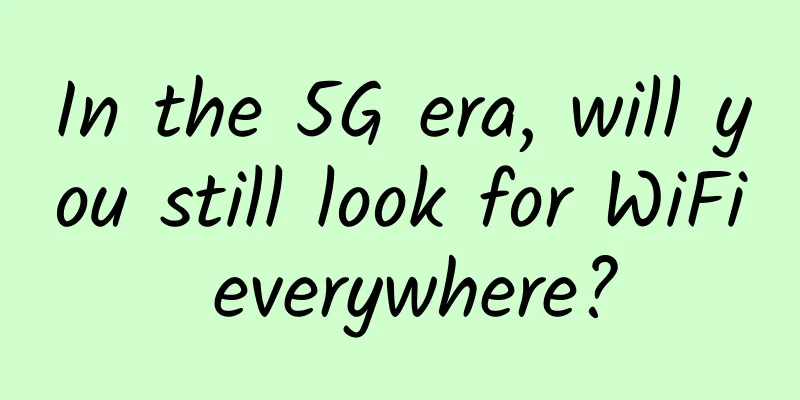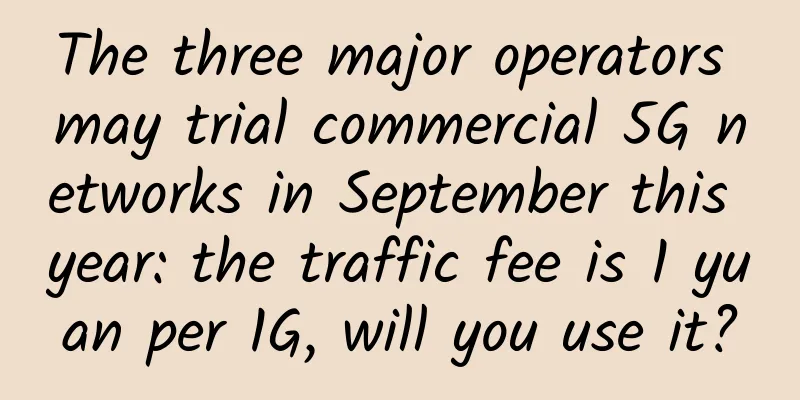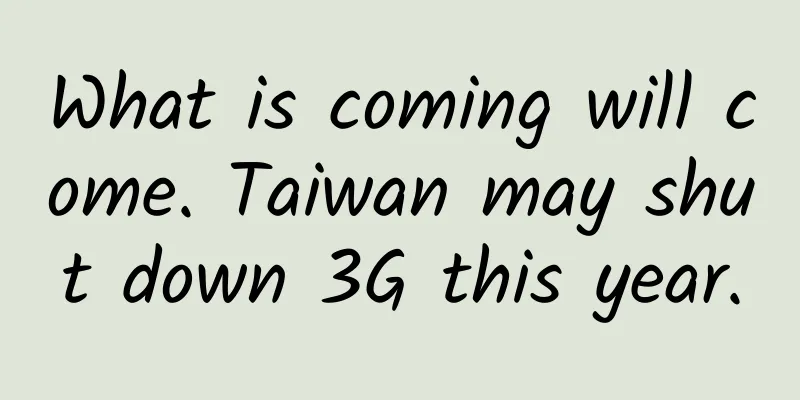In the 5G era, will you still look for WiFi everywhere?

|
Watching short video apps like Tik Tok and Kuaishou is becoming a way of leisure and entertainment for more and more young people. 4G is increasingly unable to meet our needs for quickly browsing such videos. 5G is about to be released. Not long ago, the three major operators announced the first batch of 5G pilot cities, and the footsteps of the 5G era are getting closer and closer. Mobile phone numbers are no longer necessary, social media apps are more dominant The development of modern human society is accompanied by the development of communication technology. From the earliest telegraphs and telephones to modern mobile communication technology, it is the convenience of communication that has accelerated the progress of history. From 2G in the early 1990s, 3G in the late 1990s to 4G that emerged around 2010, the evolution of the communication world is almost an era every 10 years.
In the 2G era, most scenarios involved connections between computers; in the 3G/4G era, the trend began to shift to connections between people; in the 5G era, people and things, things and things will form a connection matrix, and each person and thing will become a node on the Internet, exchanging data with each other to form a large data network. This will fundamentally change our way of life and will also subvert the current mode of production. What ordinary users can most easily feel is that the peak rate of 5G is expected to reach the order of 10Gbps. In the 4G era, manufacturers or operators often announced that their network speeds could achieve a maximum rate of hundreds of megabits, but this requires two prerequisites: first, there is only one user in the cell, and second, this user encounters a randomly changing channel with extremely good conditions. But in the 5G era, a rate of 100 megabits can be easily achieved without these prerequisites. Thanks to the rational use of spectrum resources, in the 5G era we will enjoy an Internet experience with better coverage and stability than the current 4G. In most places where 2G signals can currently be covered, we will be able to easily download a movie within a few seconds in the future. We will enter the era of full traffic. Of course, calling and texting can also be done by using data traffic. In this case, mobile phone contacts and mobile phone numbers are no longer something we must use - users will be more inclined to contact each other through social software. Whichever app has the best experience and the widest coverage, users will use it to contact each other. Under such circumstances, social software companies led by Tencent will further consolidate their dominant position, and operators' dominance over numbers will be further weakened. The premise of the full traffic era is cheap tariffs. In the 2G and 3G eras, people lived by the amount of traffic they used. In the 4G era, the cost per unit of traffic has dropped significantly, but due to the rise of 4G high-speed and high-definition video applications, users' demand for traffic has grown exponentially. Therefore, the sharp drop in the cost per unit of traffic has not reduced users' total traffic expenditure. Instead, the demand for traffic from many applications has stimulated a sharp increase in users' total traffic expenditure. In the 5G era, according to the development law of previous generations of mobile communication technology, the network speed has increased by more than 100 times, and users' demand for traffic will once again increase exponentially. Although the demand for traffic has increased exponentially, the total cost actually spent by users is not necessarily more than that in the 4G era. This is because, on the one hand, the speed of 5G is more than 100 times that of 4G, but the cost of operators to build 5G networks may not be more than that of 4G networks. Therefore, the cost per unit of traffic will inevitably drop significantly; on the other hand, with the continuous improvement of the network and the increase in users, the tariff level for both voice and data communications is generally on a downward trend. If the price of data traffic is as cheap as cabbage, will you still look for free WIFI everywhere? Remote automatic driving of vehicles from dozens of kilometers away During the 2017 Mobile World Congress, telecommunications operators and car manufacturers jointly completed a remote driving demonstration. The demonstration was based on a smart driving car independently developed by the car manufacturer. The remote driving console was installed in Shanghai, while the real car was more than 30 kilometers away in Jiading. In a real 5G network environment, multiple high-definition cameras installed on the vehicle transmitted multiple high-definition videos of 240-degree driving angles to the remote driving console in real time, and the on-site measured uplink transmission rate reached 50Mbps. On the remote driving console, the driver directly performs driving operations based on the multiple HD videos sent back. Every action of the driver on the steering wheel, brake and accelerator is transmitted to the vehicle in Jiading within 10 milliseconds. The timely input of HD videos and the timely output of control signals make the driver feel as if he is in a vehicle dozens of kilometers away, and can perform driving operations easily and accurately. All of this is due to the large bandwidth and low latency capabilities of the 5G network. Remote autonomous driving has a wide range of application scenarios, especially in harsh environments and dangerous areas such as mining areas, garbage transportation areas, foundation compaction areas and other areas that are inaccessible to personnel. Remote driving can be performed to improve efficiency and save manpower. At the same time, remote driving can also be used as a supplement to autonomous driving. For example, in car rental and car sharing scenarios, a driver can manage multiple cars and move cars from remote areas to densely populated areas through remote driving, thereby improving vehicle utilization. Also last year, a domestic telecommunications equipment manufacturer and universities cooperated to conduct a series of vehicle platoon autonomous driving tests based on 5G networks in Germany and China, and successfully completed multiple scenario demonstrations such as emergency braking, close tracking, and coordinated lane changing. In these scene demonstrations, two or more vehicles are traveling in the same direction, with the front vehicle acting as a pilot vehicle and a human driver, while the rear vehicle is unmanned. When the front vehicle performs emergency braking, lane changing, or turning, the control signal is transmitted to the rear vehicle in real time through the 5G base station. The rear vehicle receives the signal command with extremely low latency and makes coordinated actions with the front vehicle in a timely manner. Field tests have shown that based on the high reliability and ultra-low latency of 5G, the end-to-end latency of the transmission of commands between the leading and trailing vehicles can be controlled to a minimum of 5 milliseconds, greatly shortening the reaction time of the trailing vehicle, thereby keeping the entire convoy in step. The safe distance between vehicles can also be reduced, directly reducing fuel consumption caused by wind resistance, while also ensuring the safety of the entire convoy. Using 5G in high-density convoys will significantly reduce fuel consumption and save the labor costs of hiring drivers. Watching 8K videos on mobile wireless network is not a problem In the past one or two years, with the reduction of 4G network charges, people's demand for using data to play videos has also grown rapidly, such as the recently popular short video applications such as Douyin and Kuaishou. Opening recording, playback, and uploading at any time has become a favorite leisure and entertainment method for many young people. However, in the coming 5G era, various video applications will continue to develop towards high definition. As the hardware for 4K video has matured, 8K technology increasingly represents the direction of future video technology development. 8K live broadcast has been trial-run at the Rio Olympics in Brazil, and Japan will also use 8K technology to broadcast the Tokyo Olympics in 2020. As 8K video develops, it will inevitably place higher demands on operators and even the entire industry chain. 4K ultra-clear services require a stable bandwidth of 50Mbit/s, which is no longer possible with the average 40Mbit/s 4G network. And after 100 times compression, the transmission rate of 8K (3D) video still requires about 1Gbps. The popularization of these services requires the support of a new generation of wireless networks with better performance, which can only be met by 5G technology. From the first to the fourth generation of mobile communication technology, they all revolve around communication between people. However, a truly intelligent life requires the realization of "Internet of Everything", which is not only the connection between people and these devices, but also the connection between these devices. Although the current 4G network can provide a relatively ideal network speed, it is not enough to support the Internet of Everything due to its limited capacity. The substantial increase in 5G network capacity provides the conditions for the realization of "Internet of Everything". In the 5G era, as the cost of hardware such as sensors and modems decreases and the network can provide low-power, low-cost connections, asset tracking will be extended to more goods in transit. Imagine that you can know the detailed location of every online shopping package in the future. It can also enable logistics companies to achieve refined management, thereby improving the overall work efficiency of the logistics industry. In the 5G era, more infrastructure will be connected by mobile networks, such as street lights, water meters, and trash cans. City managers can accurately know the status of each infrastructure, such as which street light is broken, which section of the water pipe is leaking, and which trash can is full. This is undoubtedly of great significance for improving the efficiency of urban operations and facilitating people's lives. |
<<: Five major events in global 5G communication technology and deployment in the past two weeks
Recommend
How will Yang Jie take the helm of China Mobile when the net profits of the two operators differ by 5 times?
It is not easy to "steer" China Mobile....
A 10,000-word article that explains computer networks with pictures!!!
[[383719]] The author has developed a simple, sta...
After 6G, will there be 7G and 8G?
But in any case, from 1G to 5G, it has developed ...
GreenCloudVPS: Japan VPS with 500GB hard disk for $50 per year, KVM, available in Osaka & Tokyo
I have shared information about GreenCloudVPS sev...
How is vmiss? Simple test of vmiss Hong Kong VPS (CN-Hong Kong-BGP)
At the beginning of last month, we purchased the ...
What Internet speed do smart homes need?
The Internet of Things (IoT) is changing the way ...
What is CDN? A detailed explanation of CDN in one article
[[254871]] In today's mobile Internet era, mo...
Foreign media: Germany may completely shut down 3G network in 2022
Deutsche Telekom has become the third major opera...
How will AI and 5G drive the next wave of innovation?
Artificial intelligence (AI) continues to permeat...
In the 5G era, smart services will become the new normal
More than a year after its official commercial la...
Hacking Bitcoin and the Blockchain
Turn on the TV or read a tech blog, and you will ...
Sharktech Spring Promotion, 10Gbps unlimited traffic high-defense server starting from $299/month, 2*E5-2678v3/128G/2TB NVMe/4 computer rooms including Los Angeles
Sharktech has launched a spring promotion, with d...
[6.18]DogYun: 30% off on Elastic Cloud, 20% off on Classic Cloud, 68 yuan free for 618 yuan top-up, Hong Kong/Korea dedicated servers starting from 300 yuan/month
DogYun (狗云) has announced this year's 618 Hap...
As the natural environment becomes increasingly harsh, underground data centers are becoming a trend
Scientific research over the past few decades has...
NTT and Cisco team up to provide integrated collaborative communications solutions
NTT and Cisco jointly provided an integrated coll...









